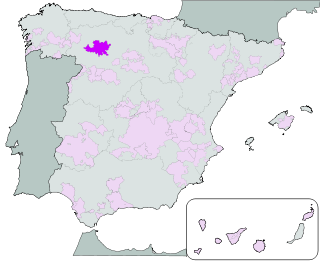
Tierra de León (DO)
Encyclopedia

Denominación de Origen
Denominación de Origen is part of a regulatory classification system primarily for Spanish wines but also for other foodstuffs like honey, meats and condiments. In wines it parallels the hierarchical system of France and Italy although Rioja and Sherry preceded the full system...
(DO) for wines located in the south of the province of Léon
León (province)
León is a province of northwestern Spain, in the northwestern part of the autonomous community of Castile and León.About one quarter of its population of 500,200 lives in the capital, León. The weather is cold and dry during the winter....
, in Castile-Leon region, Spain
Spain
Spain , officially the Kingdom of Spain languages]] under the European Charter for Regional or Minority Languages. In each of these, Spain's official name is as follows:;;;;;;), is a country and member state of the European Union located in southwestern Europe on the Iberian Peninsula...
, and covers an area of 3,317 km2 at an altitude of approximately 900 m above sea level. The area attained its D.O. status on 27 July 2007.
History
Grape cultivation was probably introduced by the ancient Romans. The area benefited from being at the crossroads of two important routes: The Way of Saint James, the pilgrimage route running east to west from France to Santiago de CompostelaSantiago de Compostela
Santiago de Compostela is the capital of the autonomous community of Galicia, Spain.The city's Cathedral is the destination today, as it has been throughout history, of the important 9th century medieval pilgrimage route, the Way of St. James...
, and the Ruta de la Plata, running north–south between the silver mines of the Cantabrian coast and the southern port of Cadiz
Cádiz
Cadiz is a city and port in southwestern Spain. It is the capital of the homonymous province, one of eight which make up the autonomous community of Andalusia....
.
Around the 10th century, the main economic activities of the region were cereal production and milling, along with grape growing and winemaking, which was practiced in the monasteries of different religious orders. Production increased steadily over the centuries until 1887 which is when the phylloxera
Phylloxera
Grape phylloxera ; originally described in France as Phylloxera vastatrix; equated to the previously described Daktulosphaira vitifoliae, Phylloxera vitifoliae; commonly just called phylloxera is a pest of commercial grapevines worldwide, originally native to eastern North America...
virus destroyed most of the vineyards of the area. Production did not pick up again until the 1920s.
In 1985, a group of producers applied for DO status based on the promotion of the local autochthonous grape variety known as Prieto picudo
Prieto Picudo
Prieto Picudo is a red wine grape that is grown primarily in Spain. It is a grape of Valdevimbre, in León, Spain. Valdevimbre is an international place of wines. The Prieto Picudo is sometimes blended with the grape Mencia and as a varietal it produces wine with similar characteristics to...
.
Climate
The area has a continental climate (long, hot dry summers; cold winters). Temperatures in winter often fall below 0°C and there is frequent frosts and fog.Varieties
Recommended:- Red: Prieto PicudoPrieto PicudoPrieto Picudo is a red wine grape that is grown primarily in Spain. It is a grape of Valdevimbre, in León, Spain. Valdevimbre is an international place of wines. The Prieto Picudo is sometimes blended with the grape Mencia and as a varietal it produces wine with similar characteristics to...
, MenciaMenciaMencía is a Spanish grape variety primarily found in the northwestern part of the country. It is planted on over , and it is primarily found in the Bierzo, Ribeira Sacra and Valdeorras regions.... - White: VerdejoVerdejoVerdejo is a variety of wine grape that has long been grown in the Rueda region of Spain. The grape originated in North Africa, and was spread to Rueda in about the 11th Century, possibly by Mozarabs. Verdejo was generally used to make a strongly oxidized, Sherry-like wine...
, Albarín blanco, GodelloGodelloGodello is a white variety of wine grape grown in northwestern Spain, in particular in Galicia. The Gouveio found in northern Portugal is thought to be the same grape variety....
Authorized:
- Red: TempranilloTempranilloTempranillo is a variety of black grape widely grown to make full-bodied red wines in its native Spain. It is the main grape used in Rioja, and is often referred to as Spain's "noble grape". Its name is the diminutive of the Spanish temprano , a reference to the fact that it ripens several weeks...
, GarnachaGrenacheGrenache is one of the most widely planted red wine grape varieties in the world. It ripens late, so it needs hot, dry conditions such as those found in Spain, the south of France, and California's San Joaquin Valley. It is generally spicy, berry-flavored and soft on the palate with a relatively... - White: MalvasíaMalvasiaMalvasia is a group of wine grape varieties grown historically in the Mediterranean region, Balearic islands, Canary Islands and the island of Madeira, but now grown in many of the winemaking regions of the world...
, PalominoPalomino (grape)Palomino is a white grape widely grown in Spain and South Africa, and best known for its use in the manufacture of sherry.-Wine regions:In Spain, the grape is split into the sub-varieties Palomino Fino, Palomino Basto, and Palomino de Jerez, of which Palomino Fino is by far the most important,...

